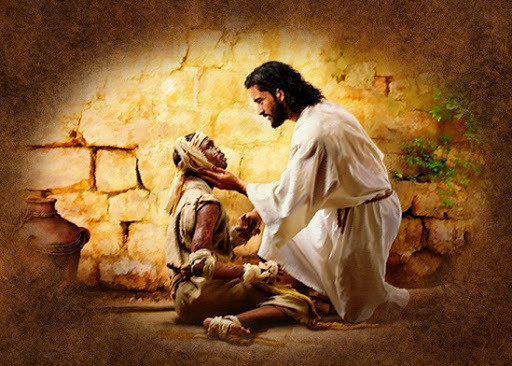By Stephen Ojapah MSP
According to the Gospel of Matthew, when Jesus Christ came down from the mountain after the Sermon on the Mount, large multitudes followed him. A man full of leprosy came and knelt before Him and inquired him saying, “Lord”, if you are willing, you can make me clean.”
- Family members of murdered ISIS fighters repatriated to Abuja
- PODCAST: IDP Camps: A Ticking Time Bomb
Multiple people who were lepers followed this man to get cured. Mark and Luke don’t connect the verse to the Sermon. Jesus Christ reached out his hand and touched the man. “I am willing,” he said. “Be clean!” Instantly he was healed of his leprosy.
Then Jesus said to him, “See that you don’t tell anyone. But go, show yourself to the priest and offer the gift Moses commanded, as a testimony to them.” In Mark and Luke instead he went out and began to talk freely, spreading the news. As a result, Jesus could no longer enter a town openly but stayed outside in lonely places. Yet the people still came to Him from everywhere. (Mathew 8: 1- 4, Mark 1:40–45 and Luke 5:12–16).
There is some speculation as to whether the illness now called Hansen’s disease is the same described in Biblical times as leprosy. As the disease progresses, pain turns to numbness, and the skin loses its original color and becomes thick, glossy and scaly. Sores and ulcers develop, especially around the eyes and ears, and the skin begins to bunch up with deep furrows between the swellings so that the face of the afflicted individual looks similar to that of a lion. Since the disease attacks the larynx also, the voice becomes hoarse and acquires a grating quality.
Leviticus 13 outlines specific procedures for dealing with a person suspected of being infected with leprosy. A priest would have to inspect the lesion, and after a period of monitoring and observation, if the condition did not improve, the person would be declared ritually unclean. Leprosy was considered a sort of curse from God, of profound impurity. To be declared unclean because of leprosy meant that the unfortunate person had to tear his clothes and put a covering upon his upper lip and cry, “unclean, unclean.” As the Jews were concerned that the condition was contagious, such individuals were to live separate outside the camp. Ostracized from the community, they were left homeless without the support structure of family and friends. In approaching Jesus, the man was in violation of Levitical law. In touching the leper, Jesus also defies Levitical law. When the Son sent forth the disciples with instructions to heal the sick, cleansing the lepers was specifically mentioned in Mathew 10: 8.
When we began training for the Catholic Priesthood in Iperu Remo Ogun State, all of us had to do a mandatory study on the life of Fr Damien of Molokai. Studying about him then didn’t really make a lot of sense to me, because there was really nothing at stake. Years later, I remember the wealth of his life and sacrifice which he left for humanity, especially Nigeria and her leaders.
Fr Damien Was a Priest from Belgium and member of the Congregation of the Sacred Hearts of Jesus and Mary a Missionary Religious Institute? He was recognized for his ministry, which he led from 1873 until his death in 1889, in the Kingdom of Hawai’i for people with leprosy, who lived in government-mandated medical quarantine in a settlement on the Kalaupapa Peninsula of Molokai During this time, he taught the Catholic faith to the people of Hawaii. Father Damien also cared for the patients and established leaders within the community to build houses, schools, roads, hospitals, and churches. He dressed residents’ ulcers, built a reservoir, made coffins, dug graves, shared pipes, and ate poi by hand with them, providing both medical and emotional support. After eleven years caring for the physical, spiritual, and emotional needs of those in the leper colony, Father Damien contracted leprosy. He continued with his work despite the infection but finally succumbed to the disease on 15 April 1889.
While Bishop Louis Desire Margret, the vicar apostolic of the Honolulu diocese, believed that the lepers needed a Catholic priest to assist them, he realized that this assignment had high risk. He did not want to send any one person “in the name of obedience.” After much prayer, four priests volunteered to go, among them Father Damien. The bishop planned for the volunteers to take turns in rotation assisting the inhabitants.
On 10 May 1873, the first volunteer, Father Damien, arrived at the isolated settlement at Kalaupapa, where there were then 600 lepers, and was presented by Bishop Louis Maigret. At his arrival, he spoke to the assembled lepers as “one who will be a father to you, and who loves you so much that he does not hesitate to become one of you; to live and die with you. Fr Damien worked with them to build a church and establish the Parish of Saint Philomena. In addition to serving as a priest, he dressed residents’ ulcers, built a reservoir, built homes and furniture, made coffins, and dug graves. Six months after his arrival at Kalawao, he wrote to his brother, Pamphile, in Europe: “…I make myself a leper with the lepers to gain all to Jesus Christ.”
During this time, Father Damien had cared for the lepers and established leaders within the community to improve the state of living. Father Damien aided the colony by teaching, painting houses, organizing farms, organizing the construction of chapels, roads, hospitals, and churches. He also dressed residents, dug graves, built coffins, ate food by hand with lepers, shared pipes with them, and lived with the lepers as equals. Father Damien also served as a priest during this time and spread the Catholic faith to the lepers; it is said that Father Damien told the lepers that despite what the outside world thought of them, they were always precious in the eyes of God.
Father Damien worked for 16 years in Hawaii, providing comfort for the lepers of Kalaupapa. He gave the people not only faith but also homes and his medical expertise. He would pray at the cemetery of the deceased and comfort the dying at their bedsides. In December 1884, while preparing to bathe, Damien inadvertently put his foot into scalding water, causing his skin to blister. He felt nothing and realized he had contracted leprosy after 11 years of working in the colony. This was a common way for people to discover that they had been infected with leprosy. Despite his illness, Damien worked even harder.
In 1885, Masano Gato, a Japanese leprologist, came to Honolulu and treated Damien. He believed that leprosy was caused by a diminution of the blood. His treatment consisted of nourishing food, moderate exercise, and frequent friction to the benumbed parts, special ointments, and medical baths. The treatments did relieve some of the symptoms and were very popular with the Hawaiian patients. Damien had faith in the treatments and said he wanted to be treated by no one but Goto, who eventually became good friends with Father Damien.
Fr Damien eventually died and was buried in 1889 in the company of only lepers. At that point no one could dig graves as he did with normal hands and fingers. He left indelible impression in the lives of those over 600 lepers, but humanity remembers him eternally. The lessons to learn from such a great man are enormous. We could take different insights from his lifestyle and selflessness. His sacrifice is only next to Christ. His sense of creativity in serving his people is unimaginable, one thing I feel leaders at all level should keep in mind is simply this. Leadership is all about managing people. One can build the best skyscrapers in the world; how you managed those who build the skyscrapers determines the quality of your services to man and God.
Fr Stephen Ojapah is a priest of the Missionary Society of St Paul. He is equally the director for Interreligious Dialogue and Ecumenism for the Catholic Diocese of Sokoto, a member of IDFP. He is also a KAICIID Fellow

 Join Daily Trust WhatsApp Community For Quick Access To News and Happenings Around You.
Join Daily Trust WhatsApp Community For Quick Access To News and Happenings Around You.


